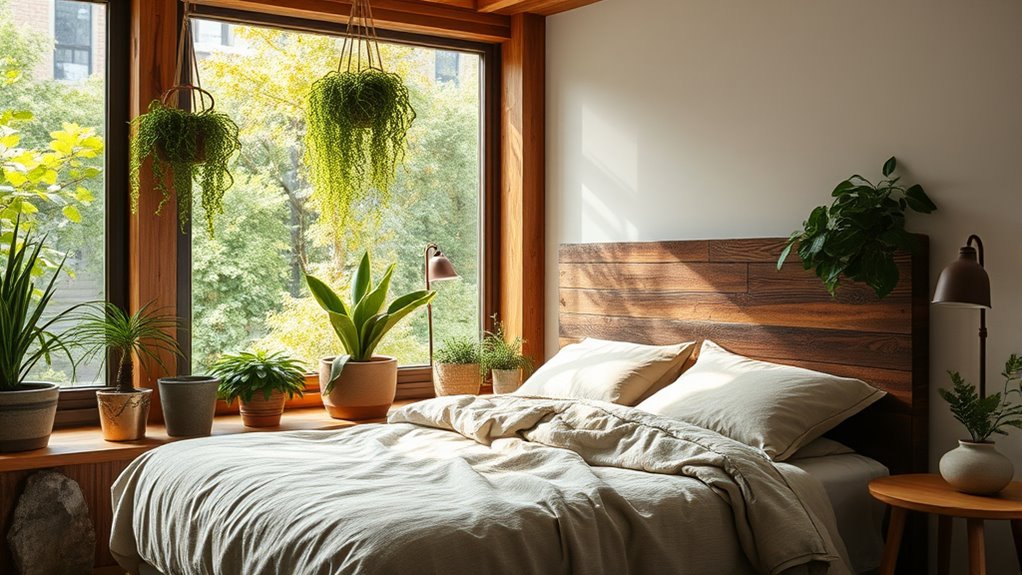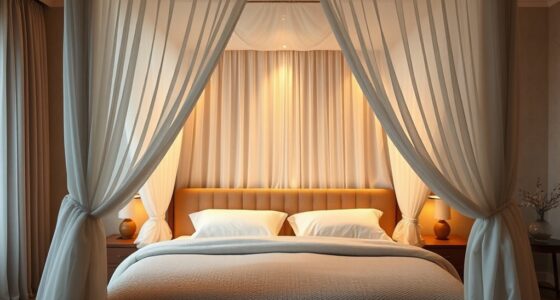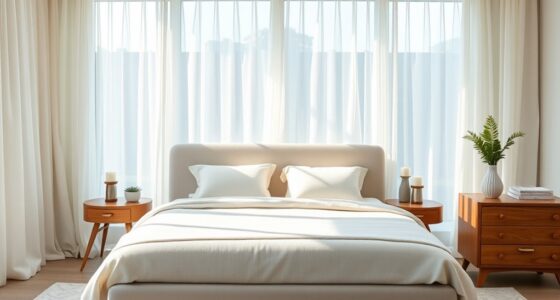To create a biophilic bedroom that promotes better sleep, incorporate indoor plants like peace lilies or snake plants to boost air quality, and maximize natural light with sheer curtains or strategic furniture placement. Use earthy tones, natural fabrics, and wooden accents to deepen your connection to nature. Adding mirrors can amplify sunlight and brighten your space. Embracing these simple elements helps reduce stress and improve overall wellbeing—discover more ways to bring nature indoors for restful nights.
Key Takeaways
- Incorporate indoor plants like peace lilies, snake plants, and pothos to improve air quality and create a calming atmosphere.
- Maximize natural light with strategic window placement and light diffusing treatments to boost mood and sleep quality.
- Use natural materials such as linen, cotton, wood accents, and earthy tones to enhance the biophilic ambiance.
- Add mirrors to reflect sunlight and increase brightness, making the space feel more open and energizing.
- Design the room to mimic outdoor environments, promoting relaxation, reducing stress, and supporting overall wellbeing.

Creating a biophilic bedroom design brings nature indoors, transforming your space into a calming retreat. When you incorporate indoor plants and maximize natural lighting, you create an environment that nurtures both your body and mind. Indoor plants aren’t just decorative; they improve air quality and add a touch of serenity to your space. Choose plants like peace lilies, snake plants, or pothos—easy to care for and effective at filtering toxins. Place them near windows or in spots where they can thrive without requiring constant attention. These green elements introduce a natural vibrancy that instantly makes your bedroom feel more peaceful and inviting.
Indoor plants enhance air quality and bring serenity to your bedroom space.
Maximizing natural lighting is equally vital in fostering a biophilic atmosphere. Open your curtains or blinds during the day to invite sunlight into your room. Sunlight not only lifts your mood but also regulates your circadian rhythm, helping you sleep better at night. If your room doesn’t get much direct sunlight, consider using sheer curtains or light-colored window treatments that diffuse the light softly across your space. Strategically positioning your bed and furniture to take advantage of natural light enhances the sense of openness and connection to the outdoors. As you bring in more natural light, your bedroom starts to feel less confined and more like a soothing sanctuary.
To deepen the connection with nature, select window treatments and decor that reflect natural elements. Use linen or cotton fabrics instead of synthetic ones, and incorporate earthy tones like greens, browns, and soft neutrals. These colors work harmoniously with indoor plants and natural light, reinforcing the biophilic vibe. Adding mirrors can also amplify the sunlight, bouncing it around the room and creating a brighter, more energetic space. It’s about crafting an environment that mimics the outdoors as closely as possible, so you feel less stressed and more relaxed. Incorporating natural elements such as wood accents or stone decor can further enhance this connection.
Incorporating indoor plants and optimizing natural lighting is a simple yet powerful way to enhance your sleep quality and overall wellbeing. These elements help create a sanctuary that feels connected to nature, encouraging calmness and reducing stress. When you wake up each morning surrounded by greenery and bathed in natural light, you set a positive tone for the day. Over time, this biophilic approach can transform your bedroom into a restorative haven that promotes better sleep and a healthier, more balanced lifestyle.
Frequently Asked Questions
How Does Biophilic Design Impact Mental Health?
You’ll notice that biophilic design reduces stress and boosts your mood, making you feel calmer and more focused. By connecting you to nature, it encourages relaxation and helps lower anxiety levels. This connection also promotes cognitive enhancement, so you think more clearly and creatively. Overall, integrating natural elements into your space positively impacts your mental health, helping you feel more balanced, energized, and resilient throughout your day.
What Are Cost-Effective Ways to Incorporate Nature Into Bedrooms?
Bringing nature into your bedroom doesn’t have to break the bank—you can transform your space with budget-friendly greenery like potted plants or succulents. Try DIY natural decor, such as homemade plant hangers or painted stones, to add a personal touch. These small, affordable steps instantly create a calming, nature-inspired atmosphere, making your bedroom feel like a peaceful retreat. You’ll be amazed at how little effort creates a big, restorative difference!
Can Biophilic Elements Improve Sleep Quality Long-Term?
Yes, biophilic elements can improve your sleep quality long-term. By increasing natural light, you regulate your circadian rhythm, helping you fall asleep faster and wake refreshed. Good air quality from plants reduces indoor pollutants, creating a healthier environment. Over time, these natural features support better sleep patterns, boost relaxation, and enhance overall well-being, making your bedroom a restorative sanctuary.
Are There Specific Plants Best Suited for Bedrooms?
You should choose plants like snake plants, pothos, or peace lilies for your bedroom because they excel in plant selection and air purification. These plants are low-maintenance, thrive indoors, and help improve air quality, which can enhance your sleep. Make sure to place them where they get indirect sunlight, and avoid overwatering. Incorporating these plants creates a calming, natural environment ideal for restful sleep.
How to Maintain Indoor Plants Without Allergies?
Imagine your indoor garden as a gentle guardian, protecting your breath and peace. To keep it allergy-friendly, choose air purifying plants like snake plants or pothos, which filter toxins without triggering allergies. Guarantee pet safety by avoiding toxic varieties such as lilies or philodendrons. Regularly dust and inspect your plants, and keep the area well-ventilated. This way, your green sanctuary nurtures your health and serenity effortlessly.
Conclusion
So, who knew that inviting a little nature into your bedroom could actually help you sleep better? It’s ironic, isn’t it? We chase after fancy gadgets and high-tech mattresses, but sometimes, all it takes is a few plants and natural light to turn your space into a restful retreat. Next time you struggle to sleep, maybe forget the latest sleep app and just step outside—or bring the outdoors in. Nature really is the best remedy.








